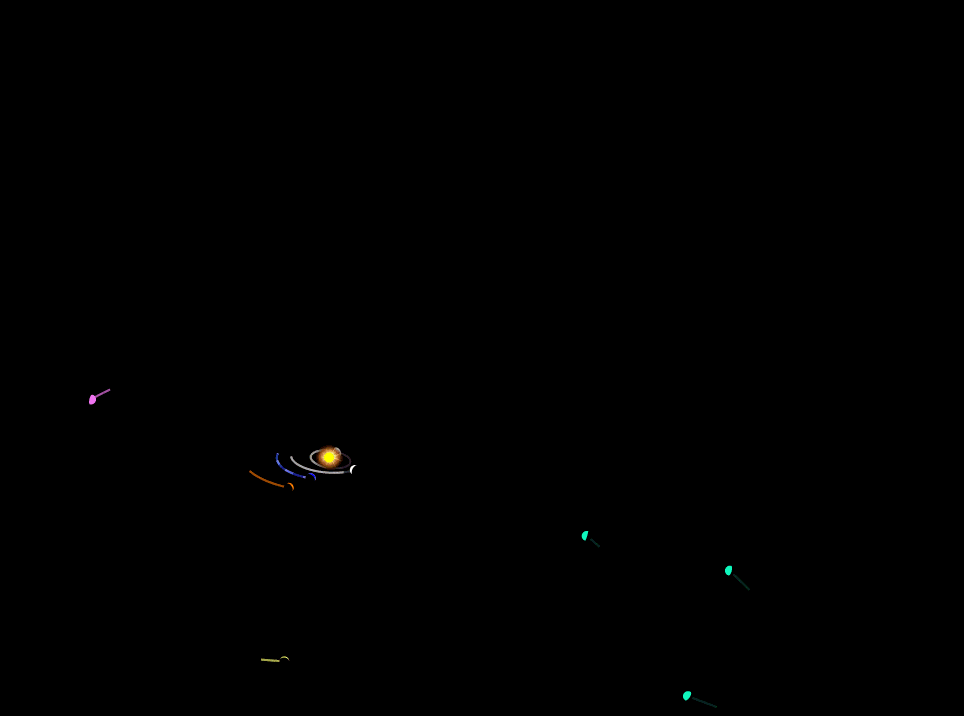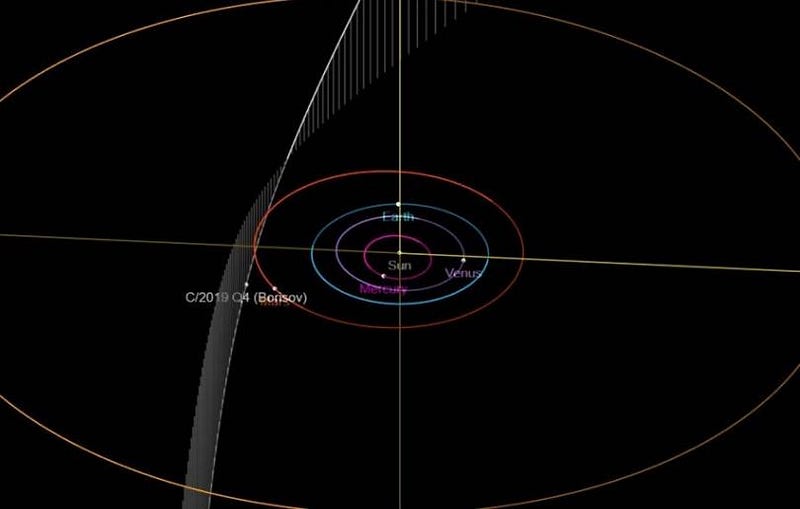Goodbye ‘Oumuamua, Hello Borisov; This Is What Two Interstellar Interlopers Can Teach Us

Forget about alien nonsense. The Universe as it actually is doesn’t need any embellishments to be interesting.
In our Solar System, the planets, moons, asteroids, comets and other masses are all engaged in a great gravitational dance, with the Sun serving as the main source of mass in our local neighborhood. From the Kuiper belt and even the distant Oort cloud, a chance interaction or gravitational tug occasionally sends objects from out beyond Neptune into the inner Solar System, where they’ll become comets. Some will enter more tightly bound orbits, meaning the cometary passes will recur, while others will receive gravitational kicks that eject them from the Solar System entirely.
But over the past few years, a new class of object has been discovered: objects that must originate from outside of our Solar System, yet by chance have passed through our local corner of space. With the first (‘Oumuamua) and second (Borisov) objects now definitively confirmed to be of interstellar origin, scientists can at last begin piecing together what’s known.

If you can find and identify any object in the vicinity of our Sun, it will only take a few quality observations spaced out appropriately to determine its orbital parameters. While orbits can generically be bound (circular or elliptical) or unbound (parabolic or hyperbolic), gravitational tugs from other objects in our Solar System can only impart speeds that lead to a very slightly unbound orbit.
The way we normally parameterize this is by talking about an orbit’s eccentricity (ε). The four possibilities for any orbit are:
- ε = 0 (circular),
- 0 < ε < 1 (elliptical),
- ε = 1 (parabolic), and
- ε > 1 (hyperbolic).
For all the objects ever discovered in our Solar System, the maximum eccentricity as of 2016 was ε = 1.057: just barely hyperbolic and consistent with an origin within the Solar System, but gravitationally kicked by Jupiter. If we restrict ourselves to the known comet-like objects not kicked by Jupiter, the maximum eccentricity ever seen was ε = 1.000009.
Starting in 2017, that changed in dramatic fashion.

The discovery of 1I/‘Oumuamua, along with the reconstruction of its orbit, showed that its eccentricity was much larger: ε = 1.19. Whereas the other objects on hyperbolic objects that have left or will leave the Solar System will travel no faster than 3.8 km/s when they escape the Sun’s gravitational pull, `Oumuamua’s speed is a whopping 26.3 km/s: similar to the relative speeds that other Milky Way stars travel at with respect to our Sun.
No object originating in the Solar System in any location, no matter which gravitational interactions occurred, could have been naturally accelerated to such a speed; it must have originated from elsewhere in the Milky Way. Although astronomers were able to take a number of important observations of this interstellar interloper, measuring its light as it left the Solar System, they were unable to detect any evidence of outgassing: not a coma, not a tail, not the molecular signatures of any volatiles.

This created a controversy, since ‘Oumuamua was so unlike all the other objects we’ve seen thus far. Although it’s quite large along its longest axis — estimated to be about the length of two American football fields — it’s relatively small in volume, and was observed to have an oscillatory pattern to its light-curve, suggesting that it’s tumbling.
Its origin is unknown; while the nearest star system (similar to Beta Pictoris, but about 5 times farther away) it could have originated from indicates that it’s been traveling for a minimum of ~4,00,000 years, it’s eminently plausible that it’s been traveling for many millions or even billions of years, circumnavigating the Milky Way in isolation many times over. Many ideas have been thrown around as respects its origin, including a foreign asteroid belt, Kuiper belt, Oort cloud, pre-solar nebula, and even (of questionable scientific merit) the idea that it could be an intentional alien spacecraft.

The lack of volatiles detected from its October 2017 discovery onwards, in spite of a close pass near the Sun just six weeks prior, teaches us that it must not be very icy. Either it’s asteroid-like, or it’s a highly depleted comet-like object that’s been thoroughly weathered by the interstellar medium. It has a uniform, slightly red color (similar to Pluto), but is very low in reflectivity (similar to Earth’s Moon).
Based on its reconstructed properties, its long axis is probably 5-to-10 times longer than the other two axes, giving it a cigar-like shape. Its tumbling nature indicates that it was “born” (i.e., sent into the galaxy or ejected from its parent system) tumbling, with its angular momentum conserved throughout all this time. There was also an anomalous acceleration of this object that was observed, but it’s entirely consistent with outgassing that’s below the detectable threshold for an object this small.

The discovery of ‘Oumuamua only opened up more questions concerning these interstellar objects and their origins.
- Is the composition, shape, size, and tumbling nature of ‘Oumuamua typical of these interlopers?
- Is this a remnant from a failed solar system, or a piece of ejecta from a fully-formed, mature system?
- Is it a rubble-pile object, a contact binary, or a solid, relatively dense object that’s been worn down to its core?
Everything we’ve seen is consistent with it originating from the Oort cloud of another star system, although many other possibilities are viable, too.
In science, whenever you observe a new phenomenon or a new class of object for the first time, you can count on theorists to concoct every reasonable idea (and many unreasonable ones) to explain what’s been observed. But in order to decide which ideas have merit, more data and more examples are needed. At the very end of August, 2019, nature provided everything astronomers could have hoped for, with the arrival of humanity’s second known interstellar interloper: 2I/Borisov.

Borisov is the second example of a large object whose origin is definitively interstellar, but it’s far more impressive in almost every way than ‘Oumuamua. Compared to ‘Oumuamua, Borisov is:
- much more eccentric (with ε = 3.35, nearly three times greater than any other object),
- much larger (with a nuclear diameter of about 6 kilometers, versus ~0.3 km),
- and a distinctly comet-like appearance, with a clear coma surrounding it and a tail more than double the extent of the coma, rich in cyanide and diatomic carbon gases.
Other than its orbital characteristics, Borisov is remarkably similar to typical comets that originate from our own Solar System. It produces comparable amounts of gas for its heliocentric distance; it appears to be similarly-sized in all three dimensions; in terms of activity, it’s extremely similar to other comets we’ve observed. Unlike ‘Oumuamua, Borisov definitively fits the template our Solar System has given us for objects originating from an outer Solar System.

Although we haven’t yet determined whether its outgassing is being primarily driven by carbon monoxide and/or water (both of which are definitely present), which we expect for a Solar System-like comet, its observed brightness trends are consistent with those two molecules, with the data already taken sufficient to rule out a “bare nucleus” model. While both Borisov’s and ‘Oumuamua’s origins remain unknown, their compositions and properties today must be radically different from one another.
But the most important point, at this moment in time, is that the scientific story of ‘Oumuamua is in the past, but Borisov’s is only just beginning to unfold. We only discovered ‘Oumuamua while it was on its way out of the Solar System, well after its closest approach to the Sun. Borisov, by contrast, is still on its way in. This time, astronomers are prepared.

It won’t be until early December that Borisov will make its closest pass to the Sun, passing interior to Mars’s orbit. Near that same exact date, Earth will be in prime position to observe it as well, as the Borisov-Earth distance will reach its minimum, too. Throughout the coming two months, we can expect a deluge of data to be taken by observing this fantastic new object.
We still have a long way to go before we arrive at a unified model of all of the interstellar objects that are out there. It’s important to remember that these are the earliest days of studying interstellar objects, we only have two so far, they’re both very different from one another, and there’s a lot more to learn. At 1000 times the mass of ‘Oumuamua, Borisov looks just like what you’d expect from another star system’s Oort cloud, but exactly how ‘Oumuamua got so volatile-poor remains in the realm of conjecture.

The most interesting aspect of what we know so far about interstellar objects is how different the first two, ‘Oumuamua and Borisov, truly are from one another. There are a number of ways to form interstellar bodies: from failed star systems in star-forming regions, from ejected asteroids, from comets, and from collisional debris. We do not know how common or rare objects of all these different types are, nor how to definitively classify the ones we’ve seen so far, but hope is on the way. Beginning in the 2020s, the Large Synoptic Survey Telescope will come online, expected to uncover dozens of such objects by 2030.
What are the size and frequency distributions of the interstellar population? How old and/or weathered are they? Are they comet-like or asteroid like; volatile-rich or volatile-free, and do different classes of object originate from different regions in the sky? Are most small objects inactive while most large ones are active? With the tip of the interstellar iceberg uncovered, the answers to these questions and more are at last within our reach.
The author thanks Bryce Bolin and Casey Lisse, coauthors on a new paper detailing and synthesizing novel observations of Borisov, for illuminating discussions and materials concerning interstellar objects.
Ethan Siegel is the author of Beyond the Galaxy and Treknology. You can pre-order his third book, currently in development: the Encyclopaedia Cosmologica.




